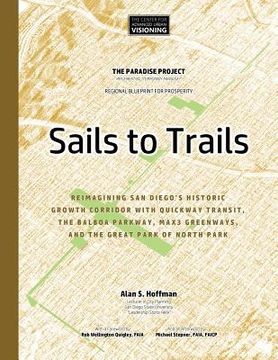Sails to Trails: Reimagining San Diego's Historic Growth Corridor with Quickway Transit, the Balboa Parkway, Max3 Greenways, and the Gr (en Inglés)
Reseña del libro "Sails to Trails: Reimagining San Diego's Historic Growth Corridor with Quickway Transit, the Balboa Parkway, Max3 Greenways, and the Gr (en Inglés)"
How should a city grow? What would be the right mix of infrastructure to support urban growth, and how can it be paid for? That is the focus of this book, using as its case study, San Diego's "Sails to Trails" corridor."Sails to Trails" (running from the sails on San Diego Bay to the Mission Trails Regional Park) hosts many of the denser, more urbanized neighborhoods in San Diego. Redevelopment of this corridor in the 1970s and 1980s replaced thousands of single-family homes with cheap "six-pack" apartment buildings; front landscaping was lost to concrete parking aprons. With little new parkland, public space, or effective transit made available to the swelling urban population, the central part of the corridor mostly stagnated. Now that Millennials and empty-nesters are rediscovering urban lifestyles, the question is how urban neighborhoods can accommodate large numbers of new residents while protecting and enhancing the quality of life of existing residents. Sails to Trails argues that successful urban transformation begins with smarter thinking about transit. Strategies that make transit significantly more effective open the door to other improvements that, when planned together, can lower costs while significantly improving impacts, better achieving long-range goals. Sails to Trails builds on a strategy of creating a flexible grade-separated transit infrastructure to link neighborhoods together with a robust network of fast, frequent, and affordable services. The first two stages, focused on vastly improving rapid transit and bicycle access to the Mid-Coast Trolley Line under construction create the basis for the Sails to Trails projects, which themselves combine water, sewer, storm water, and transit components into a "dig once" super-project, creating more opportunities to leverage state and federal dollars while reducing overall costs and magnifying results.Sails to Trails shows how targeted road improvements can improve automotive flows while freeing space on El Cajon Boulevard-the corridor's heart-to create a 2.6 mile long median park, the Balboa Parkway. With a transit tunnel beneath served by a variety of express and local electric Rapid Bus routes linking the corridor directly with most likely destinations, intensive development is clustered tightly around the Parkway and defined by a "Form-Based Code" which is developed jointly with the communities to ensure community values are protected while making it far easier for developers to build projects that meet the code. A rebuilt Boulevard can also feature Amsterdam-style bikeways that connect directly with the bicycle Greenways proposed in the first-stage projects, making it far easier and safer to commute via bicycle to several major job, retail, recreational, and residential centers.Sails to Trails further identifies how to create a completely auto-free 45-acre Great Park in the heart of North Park, built from just 7 acres of residential takings. This park, surrounded by just one block of intensive development, can, along with the Balboa Parkway's development, produce enough revenue through an Infrastructure Financing District mechanism to cover most of the local funds required to make the projects happen. Sails to Trails also describes the staging process by which the projects may be built, minimizing disruptions and maximizing positive impacts.Sails to Trails shows how a city like San Diego can better achieve its long-range goals, by focusing infrastructure where it can maximize return on investment. Far from being "pie in the sky," Sails to Trails shows how to focus growth where negative impacts can be minimized and the positives accentuated. For other cities, Sails to Trails is a case study of Advanced Urban Visioning, a process for discovering potential solutions to urban challenges.

